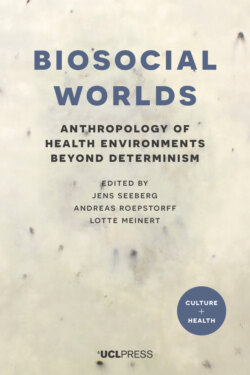Читать книгу Biosocial Worlds - Группа авторов - Страница 17
Traumatised environments
ОглавлениеA group of experts speaking at an International Geological Congress in late August 2016 declared that the geological epoch known as the Holocene through which humans have lived during the past 11,000 years and longer has been eclipsed. We are now living in the Anthropocene, an era characterised by cumulative destructive human activity on earth itself, much of it seemingly irreversible. The historian Dipesh Chakrabarty highlights the peculiarity of this new epoch: ‘the Anthropocene spells the collapse of the Kantian distinction between natural history and human history’ (Chakrabarty 2009). He bases this assertion on abundant evidence that, in contrast to previous epochs, humans are the primary force transforming the globe today, with enormous effects on human health and wellbeing. Conferences about the Anthropocene started to take place long before its formal declaration, and between 2013 and 2015, 27 had already occurred.
Numerous mineral compounds, including more than 500 million metric tonnes of pure aluminium, have been manufactured since the Second World War, much of which has sedimented into earth’s layers. Even more striking are ‘mineraloids’ – glass and plastics – 300 million tonnes of which are made annually and are present everywhere on the earth’s crust and in all the oceans. As each couple of minutes pass, Coca-Cola produces 9,000 new plastic bottles. Concrete, a rock of our own making, encases much of the globe. Our chemical footprint has accumulated worldwide as toxic waste, principally in the form of CO2, nitrogen fertilizer, pesticides, and diesel fuel.
Environment – nature – is exhibiting all the signs of stress, trauma, toxicity and abuse usually associated with suffering human bodies – the ‘ruins of capitalism’, as Anna Tsing puts it, are all too evident in vast swaths of the globe (Tsing 2015). But geologists need hard evidence of an irreversible transition in order to identify a new epoch. Their decisions are pegged to a so-called ‘golden spike’ – a marker that appears in ice-cores, the oceans, lake sediments, and soils, where recognisable fossilised strata appear that can be hammered, sampled, and/or dug up. Such changes are known as a ‘time-rock unit’. Following much debate, the International Union of Geological Sciences agreed that July 1945 constituted such a spike – the day when the first nuclear device was exploded, leaving rare isotopes of plutonium distributed all over the globe, including Antarctica and Greenland (Biello 2015).
For more than a decade we have been living with another fundamental change known as the ‘post-genomic’ era. The human genome is no longer recognised unequivocally as the driving force of life, but rather as ‘reactive’ to environments external and internal to the body (Gilbert 2003). In other words, the very ‘nature’ of what it is to be human has been revised on the basis of knowledge, largely brought to light when mapping the human genome, with enormous consequences for understanding human development, health, ill-health, and possibly our very survival.
Anthropocenic destruction of the environment and its impact on human wellbeing is not distributed equally worldwide; its effects are scalar. Readily apparent in places such as Dhaka, Bangladesh, where children as young as eight spend their days breathing in toxic fumes produced by leather tanning, in other geographical locations, closer investigation is required to discern how individual genomes everywhere are responding to environmental stimuli affecting health and wellbeing. In April 2017, Greenpeace reported that research has shown that plastic ingested by fish is liable to end up on our dinner plates; plastic pollution in our oceans is now so widespread, it is becoming part of the food chain everywhere.
